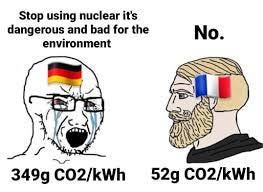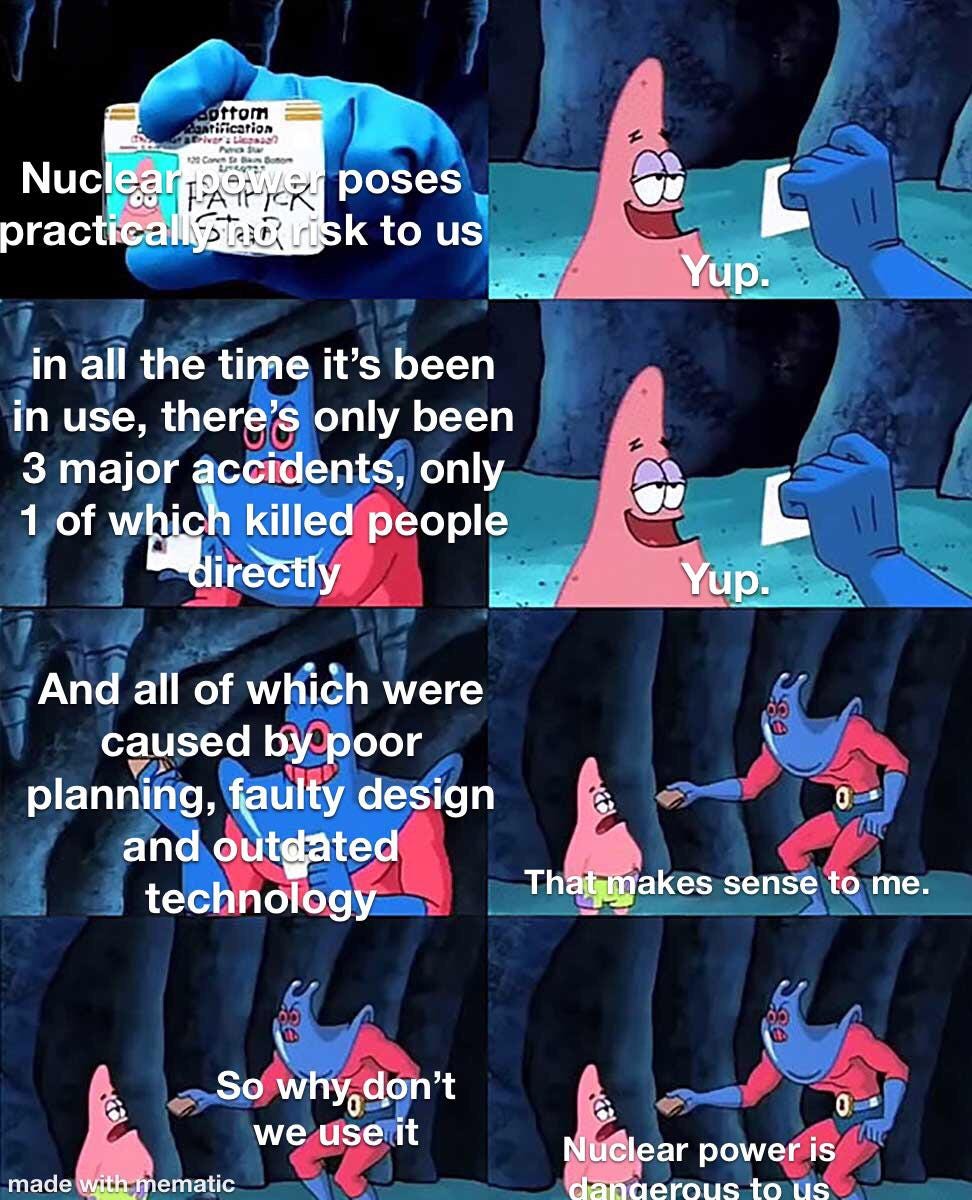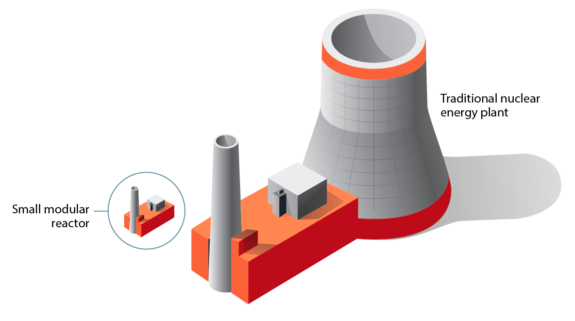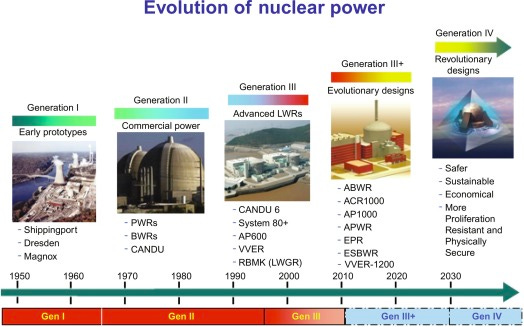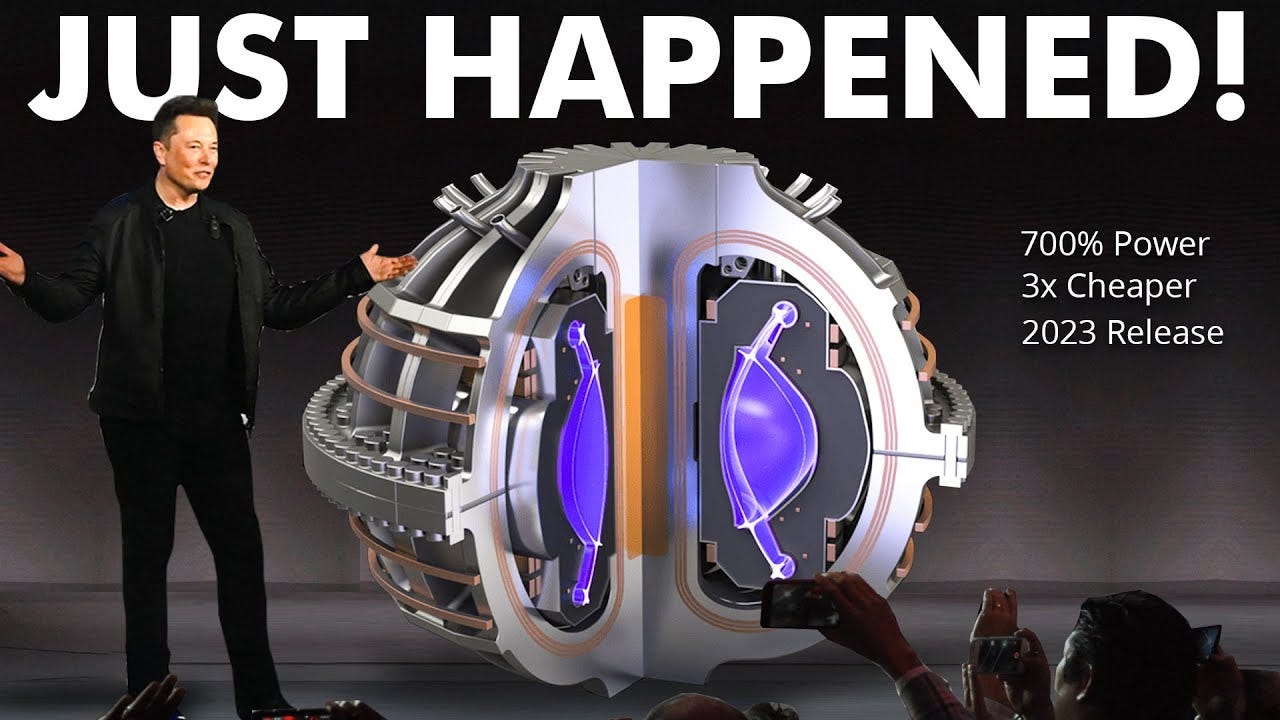Everything you need to know about Small Modular Nuclear Reactors (SMR)
So, what's the hype about SMRs? Are they even safe? And should you throw your money at SMR startups right away? All the answers below.
If you haven’t subscribed to Climate Is Cool, join our smart and curious community by subscribing here:
Hey there! 👋
Some folks say that nuclear energy isn't "green" because it has safety issues, waste disposal challenges, and the risk of it being weaponized. Others argue that it's a necessary part of the energy mix to help combat the climate crisis.
—----
Not cool
The recent debate about whether nuclear energy should be included in the European Union's green taxonomy showed that this source of energy is still highly controversial.
In fact, nuclear energy has been a topic of much debate and controversy since its inception, primarily safety concerns stemming from the potential hazards of nuclear accidents at power plants such as Three Mile Island, Chernobyl, and Fukushima.
These incidents have raised questions about the safety of nuclear power plants and their impact on the environment and public health. Additionally, a major concern surrounding nuclear energy is the challenge of long-term storage and disposal of nuclear waste. There are fears about the potential risks of waste leaks and contamination. Critics of nuclear energy also point to its high costs, from building and maintenance to decommissioning. This has led to questions about the financial feasibility of nuclear energy as a solution to global energy demands.
Lastly, the technology and materials used in nuclear energy can be utilized in the creation of nuclear weapons, raising concerns about nuclear proliferation and the risk of nuclear conflict in an increasingly unstable world.
But come on, there are a ton of good things about Nuclear Energy that we should definitely check out.
Cool
Nuclear energy is often seen as a way to mitigate global warming because it is low-carbon and can help reduce greenhouse gas emissions. It provides reliable baseload power and is considered an attractive option for countries looking to transition to a cleaner energy mix. So how do we resolve the argument? Small Modular Reactors (SMRs) are very well positioned to be one of the answers.
What are SMRs?
They are smaller and more flexible than traditional nuclear power plants, which proponents argue makes them safer and more cost-effective. However, the potential benefits of SMRs still face challenges such as concerns about safety, waste disposal, and proliferation risks.
SMRs are characterized by a number of technical features that distinguish them from traditional large-scale nuclear power plants:
Smaller in size, typically with a capacity of less than 300 megawatts, compared to traditional nuclear power plants that can have capacities of over 1,000 megawatts.
Designed to provide power to remote or off-grid locations, as well as to support larger power grids. They can operate independently or in combination with other energy sources, such as renewables.
Their small size allows for modular, scalable deployment, which can be tailored to meet the specific energy needs of a given location or community.
Use a variety of advanced nuclear technologies and are designed to be inherently safe, meaning that they can shut down automatically and safely in the event of an emergency.
Can be manufactured in a factory setting and transported to their final location, which proponents argue can reduce construction time and cost.
The concept has its roots in the 1950s, when scientific and military research on small nuclear reactors first began. During the 1950s and 1960s, small reactors were developed for use in submarines and remote locations. The first commercial SMRs were deployed in the 1960s, and the technology has evolved over the years with advances in reactor design and manufacturing. Despite their long history, SMRs remain a relatively new technology, with commercial deployments limited to a few countries.
They use different types of reactors:
Heavy Water Reactors: SMRs that use heavy water (deuterium oxide) as a coolant and moderator can operate at high temperatures and pressures, making them well suited for process heat applications, such as hydrogen production and desalination.
Light Water Reactors: SMRs that use light water (ordinary water) as a coolant and moderator are similar in design to traditional large-scale light water reactors, but on a smaller scale. They can use enriched uranium as fuel and are well suited for electric power production.
Fast Neutron Reactors: SMRs that use fast neutron reactors are designed to use fast-moving neutrons to sustain a nuclear reaction, which can allow for the use of depleted uranium or other forms of nuclear waste as fuel. They can also be designed to be inherently safe, meaning that they can shut down without the need for human intervention.
3rd generation VS 4th generation
In the nuclear energy sector, "3rd generation" refers to the current generation of commercial nuclear power reactors that are based on pressurized water or boiling water reactor designs, and were developed in the 1970s and 1980s. These reactors are characterized by improvements in safety, efficiency, and fuel utilization compared to previous generations.
"4th generation" refers to the next generation of nuclear reactors that are currently being developed. These reactors aim to further improve on the safety, efficiency, and sustainability of previous generations, and may include ground-breaking features such as passive safety systems, closed fuel cycles, and advanced materials. Some of the concepts being explored for 4th generation reactors include integral pressurized water reactors, high-temperature gas-cooled reactors, and fast neutron reactors.
Developing and implementing 3rd generation reactors has encountered challenges such as cost overruns, construction delays, regulatory hurdles, and public opposition. In contrast, 4th generation reactors are being researched and have potential to address these challenges, including safety, efficiency, sustainability, and public concerns. However, significant research, regulatory compliance, and commercialization challenges must be addressed before 4th generation reactors can be extensively deployed.
Not all Small Modular Reactors use the same underlying technology. While most of them are designed based on advanced 3rd generation technology, there are some that utilize the latest 4th generation designs. These newer designs offer the potential for significantly greater efficiency when it comes to producing decarbonized energy.
Advantages
Costs
One of the main advantages of small modular reactors is the potential for economies of scale in the manufacturing and construction process. Because SMRs are smaller in size compared to traditional large-scale nuclear power plants, they can be manufactured in a factory setting, similar to the way that automobiles or other complex products are manufactured. This allows for greater standardization, quality control, and the use of mass production techniques, which can reduce costs.
The use of a factory-based manufacturing process can result in several unit economies compared to traditional large-scale nuclear power plants. SMRs surely have lower capital costs, and they may also have shorter construction times. Additionally, maintenance and upgrades of SMRs can be performed on individual modules, which can increase operational flexibility and reduce costs. Finally, they are designed to use fuel more efficiently.
The US Energy Impact Centre has developed an open source blueprint for 114-MW SMR and provides an online economic model comparison with a 1 GW reference plant. Unit economics are compelling and the cost of electricity produced by the SMR would supposedly be almost 3 times cheaper.
Data and figures on the exact cost savings compared to traditional large-scale nuclear power plants are scarce and can vary greatly depending on the specific project. As technology advances and more SMRs are built and operated, it is likely that more accurate cost data will become available. For now, developing SMRs is still a learning-by-doing process. To assess the opportunity, one relevant approach is to compare electricity production cost of SMRs with the best available carbon-free alternative, on a case-by-case basis.
Safety
Safety is the main criticism of nuclear energy, and is also the cutting edge advantage of SMRs.
Some SMR designs incorporate inherent safety features, such as passive cooling systems, the ability to be buried, and the capability to shut down autonomously, which dramatically reduces the risk of accidents. Additionally, because they are smaller in size and designed to operate at lower power levels, there is less potential for a large release of radioactive material and reduced production of nuclear waste.
Nevertheless, SMRs are a relatively new technology with limited operating experience and a lack of data on their long-term safety performance. The regulatory framework for SMRs is still evolving, notably due to the risk of proliferation. In fact, the small size and portability of SMRs may pose a risk of nuclear proliferation, as they may be more difficult to detect and secure compared to traditional large-scale nuclear power plants.
Flexibility and scalability
Last but not least, the SMR technology is far more flexible than the traditional large-scale one. SMRs can be deployed in a variety of settings, such as remote locations or island nations, and can be scaled up or down to meet changing energy demands. Their flexibility make them well-suited for a range of energy applications, including electric power production, process heat, and desalination, they can use a variety of fuel sources. Their installation time is short and they can even be portable, such as floating nuclear power plants that can be moved to different locations, making them well-suited for use in disaster relief, military operations, and remote locations.
What’s next?
The challenges to overcome
The main challenges faced by Small Modular Reactor technology are:
SMRs are still a relatively new technology, and their commercial viability has not yet been proven. This makes it difficult for investors to evaluate the potential risks and rewards, and slows down investments in SMR projects.
SMRs have limited operational experience, and the technology is still in the early stages of development. This can make it difficult to fully understand the potential benefits and limitations of the technology.
The regulatory environment for SMRs is still evolving, and there is a risk that regulatory barriers could slow down or even halt the deployment of SMRs.
The public acceptance of SMRs is a major challenge, as there are still concerns about the safety of nuclear technology and the potential environmental impact of nuclear waste.
The development of SMRs is an expensive process and several technical hurdles remain. The high cost of research and development can be a significant barrier to the deployment of SMRs.
The players in the field
Given the large R&D costs and the dependance on political agendas, large players in the SMRs field are surprisingly global or regional utility companies with extensive experience in the nuclear sector that are often backed by governments.
NuScale Power and Oklo: US-based companies developing their own SMRs
Rolls-Royce: A UK-based multinational engineering company that is involved in the development of SMRs
Toshiba and Hitachi: Japanese companies active in the SMR sector and are working on the development of advanced SMR technologies
China National Nuclear: State-owned company in China that is involved in the development of SMRs
Électricité de France (EDF): A French electric utility company involved in the development of SMRs
Rosatom (OKBM Afrikantov subsidiary): A Russian state-owned nuclear energy corporation that is involved in the development of SMRs through its subsidiary OKBM Afrikantov
IHI: A Japanese company that specializes in heavy industries and involved in the development of SMRs
Kazakhstan Engineering: A Kazakh company that is involved in the development of SMRs in Kazakhstan and surrounding regions.
This said, there is plenty of room for great innovations and the upside potential is tremendous. The sector is logically highly appealing to stat-ups and VCs.
Last Energy (USA, 4th gen SMR): A start-up company that is developing a modular, scalable, and versatile micro-reactor for decentralized energy production and distribution.
Terrapower (USA, 3rd gen): A clean energy start-up that is developing advanced nuclear reactor technology to provide safe, clean, and affordable energy.
Arc Clean Energy (Canada, SMR, 4th gen): A start-up company that has raised C$30 million in Series A funding and is focused on the development of next-generation SMR technology.
Jimmy Energy (France, 4th gen, SMR): A European start-up that has raised €15 million in Series A funding and is focused on the development of SMRs for use in remote locations and island communities.
Transatomic Power (UK, 4th gen): A start-up company that is developing advanced reactor technology based on molten salt reactors to provide safe, clean, and affordable energy.
Moltex Energy (UK, 4th gen): A UK-based start-up that is developing advanced Stable Salt Reactor (SSR) technology to provide clean and sustainable energy.
X-energy (USA, 4th gen): A US-based start-up that is developing advanced reactor technology based on pebble bed modular reactors to provide clean and affordable energy.
Thorcon (USA and Indonesian, 4th gen SMR): An Indonesian start-up that is developing a floating SMR to provide clean energy to island communities and developing nations.
Ultra Safe Nuclear (UK, 4th gen): A US-based start-up that is developing advanced SMR technology based on liquid fluoride thorium reactors to provide safe and sustainable energy.
Arktos Brayton Systems (SMR): Developing a compact, scalable and low-cost molten salt SMR technology.
Kairos Power (USA, SMR): Working on a low-cost, high-temperature gas-cooled SMR technology.
Lightbridge Corporation (USA, SMR): Developing advanced fuel technology for use in conventional and SMR reactors.
NANO Nuclear Energy (USA, micro SMR): American strat-up developing micro-SMRs and Advanced Nuclear Reactors.
NT-TAO (Israel, 4th gen)
Conclusion
So, to sum things up, the nuclear industry has some big challenges to face, BUT it could be a key player in fighting climate change. And that's where SMR tech comes in - it looks like it could solve some of the major issues. The industry is totally buzzing with innovation and everyone from venture capitalists to start-ups are betting on this game-changing tech.
Sure, relying on new regulations might make things a bit uncertain and slow down progress, but there are some areas where SMRs are a perfect fit. For example, they could be super useful in remote areas that aren't connected to the grid, and in industrial facilities that need a lot of energy. Imagine using SMRs to create decarbonised hydrogen or sustainable aviation fuel on a massive scale!





![Image - 251838] | What People Think I Do / What I Really Do | Engineering humor, Nuclear engineering, Engineering memes Image - 251838] | What People Think I Do / What I Really Do | Engineering humor, Nuclear engineering, Engineering memes](https://substackcdn.com/image/fetch/$s_!RDD1!,w_1456,c_limit,f_auto,q_auto:good,fl_progressive:steep/https%3A%2F%2Fsubstack-post-media.s3.amazonaws.com%2Fpublic%2Fimages%2F262bfcbe-8b9f-40f9-bdf2-3c2c332f77c2_680x510.png)
